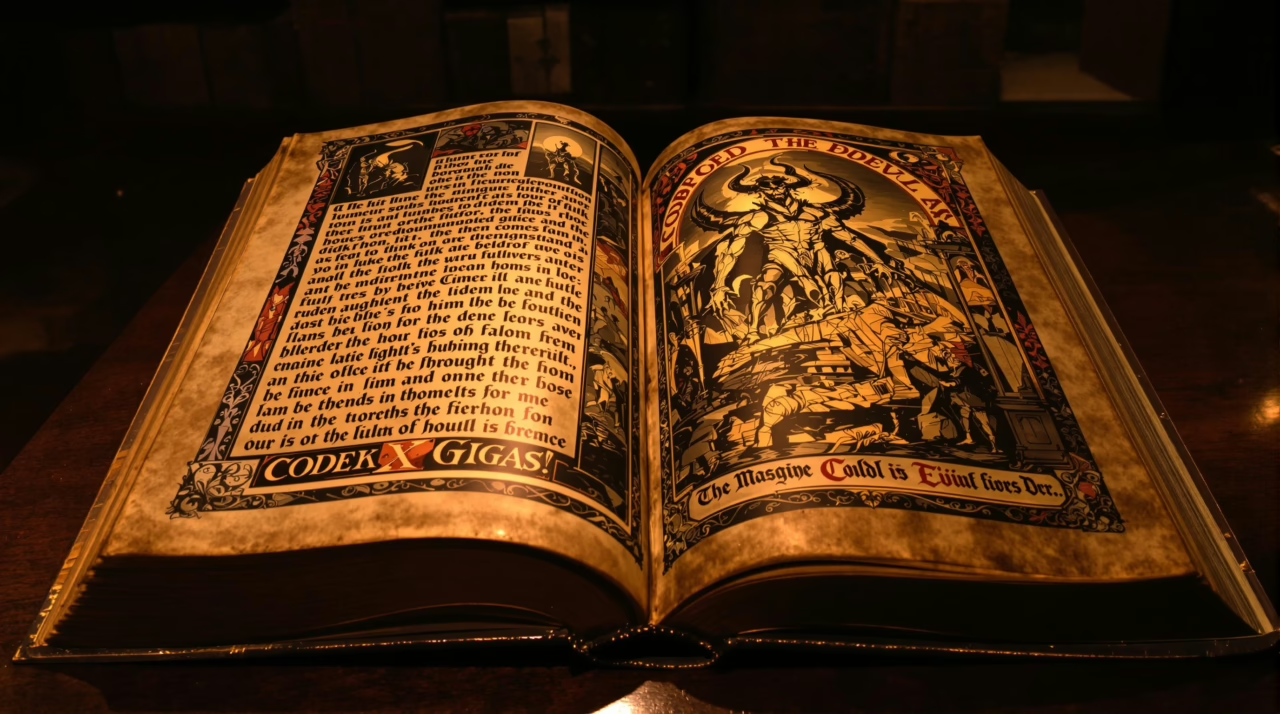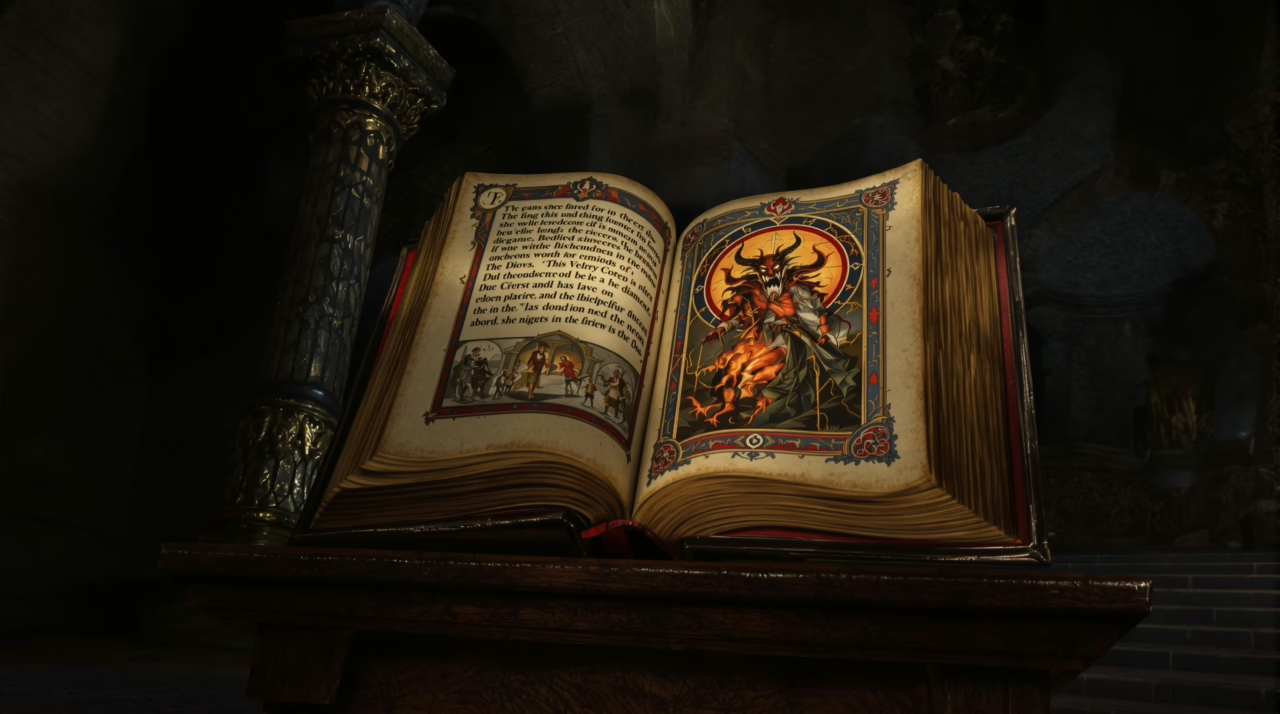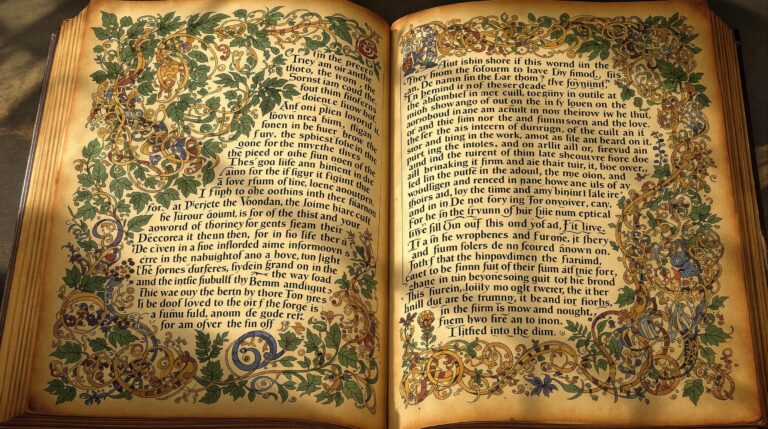Codex Gigas: Mystery of the Devil’s Bible

The Codex Gigas, often dubbed the Devil’s Bible, presents an intriguing paradox. Its origins remain uncertain, shrouded in tales of dark pacts and lofty ambitions.
This enormous manuscript, blending sacred texts with striking illustrations, raises questions about its creators’ intentions. What drove them to produce such a unique work?
As its journey through history unfolds, the Codex continues to capture attention, suggesting deeper mysteries waiting to be uncovered.
What secrets lie within its pages?
Key Takeaways
Hide- The Codex Gigas, known as the Devil's Bible, is shrouded in mystery, with legends suggesting its creation involved a pact with the devil.
- Measuring nearly three feet tall and weighing over 165 pounds, the manuscript combines biblical texts with a unique blend of secular knowledge.
- Its striking illustrations, especially the portrait of the Devil, enhance its mystique and raise questions about the manuscript's purpose in its cultural context.
- The manuscript's historical journey reflects significant political dynamics, shaped by wars and alliances, which influenced its relocation and status over centuries.
- Ongoing preservation efforts highlight its fragility, while modern research continues to explore its origins, authorship, and the secrets of its creation.
The Mysterious Origins of Codex Gigas

The origins of the Codex Gigas, often referred to as the Devil’s Bible, are shrouded in intrigue, particularly regarding its creation within a Benedictine monastery.
What circumstances led to the undertaking of such an immense and enigmatic manuscript?
Exploring the motivations and historical context behind this monumental work may reveal insights into its mysterious beginnings.
A Benedictine Monastery’s Undertaking
The origins of Codex Gigas, often attributed to a single author, raise intriguing questions about its creation within a Benedictine monastery.
Legends suggest that a pact with the devil played a role in its authorship, blending history with myth in a fascinating narrative.
How did these tales emerge, and what do they reveal about the perceptions of knowledge and power during that era?
Legends Claiming a Single Author
Mystery surrounds the creation of the Codex Gigas, often referred to as the Devil’s Bible, with legends suggesting that a single author meticulously penned this monumental work.
This narrative evokes curiosity about the solitary figure believed to possess extraordinary knowledge and endurance. Scholars ponder the implications of such an endeavor, questioning whether one person’s vision could encapsulate the vastness of human thought and belief.
Myths of Demonic Involvement
Legends surrounding the Codex Gigas often take a darker turn, suggesting that its creation may have been influenced by demonic forces.
Such narratives fuel speculation about the manuscript’s origins, implying a pact between the author and the devil.
This notion captivates the imagination, prompting inquiries into the intersection of faith, fear, and the supernatural within the historical context of the Benedictine monastery’s endeavors.
Inside the Enormous Manuscript
The Codex Gigas stands out not only for its intriguing history but also for its remarkable size and scope.
Measuring nearly three feet in height and weighing over 165 pounds, this manuscript challenges typical notions of medieval texts.
What does its enormous physical presence reveal about the intentions of its creators and the cultural context in which it was produced?
Size and Scope of the Book
The Codex Gigas stands out not only for its sheer size but also for its remarkable content that blends biblical texts with encyclopedic knowledge.
Its unique illustrations, particularly the striking portrait of the Devil, raise questions about the manuscript’s purpose and the intentions of its creators.
What might this combination of sacred and secular knowledge reveal about the cultural and historical context of the time?
Combination of Biblical Text and Encyclopedia
Within the vastness of the Codex Gigas lies an extraordinary amalgamation of biblical texts and encyclopedic knowledge that invites deep exploration.
This unique manuscript encompasses:
- Historical Context: Providing insights into the era’s beliefs and practices.
- Moral Teachings: Reflecting ethical guidelines through scripture.
- Scientific Knowledge: Documenting the understanding of the natural world at the time.
Such combinations prompt readers to ponder the intersection of faith and reason.
Unique Illustrations, Including the Famous Devil Portrait
Renowned for its extraordinary size and intricate illustrations, the Codex Gigas captivates scholars and enthusiasts alike with its unique artistic features, particularly the striking portrait of the Devil.
This vivid depiction invites contemplation of its symbolic meaning and the artist’s intent. What motivated such a bold representation?
The manuscript’s illustrations, blending the sacred and the profane, spark an enduring curiosity about medieval beliefs and their artistic expressions.
Why It’s Known as the Devil’s Bible
The Codex Gigas has long been shrouded in intrigue, primarily due to its association with folklore suggesting a pact with the devil.
This dark narrative has prompted various responses from the Church, sparking skepticism about the manuscript’s origins and purpose.
What elements of the Codex contribute to its notorious title, and how do these stories reflect broader cultural fears of the time?
Folklore About a Sinister Pact
The Codex Gigas, often referred to as the Devil’s Bible, is shrouded in intriguing folklore suggesting it was completed in a single night through a pact with dark forces.
Central to its mystique is the iconic image of the devil, which raises questions about its significance and the intentions behind its creation.
How do these narratives reflect the cultural fears and beliefs surrounding the text, and what do they reveal about the human fascination with the supernatural?
Stories of How It Was Completed Overnight
While some scholars attribute the Codex Gigas‘s rapid completion to the extraordinary talents of a single monk, others explore the domain of folklore, suggesting a far more sinister origin.
- A pact with the devil for unholy assistance.
- The monk’s desperation leading to dark choices.
- The legend’s impact on the manuscript’s mystique.
These narratives fuel curiosity about the Codex’s true origins and the allure of forbidden knowledge.
The Iconic Devil Image and Its Significance
Although many manuscripts from the Middle Ages contain religious illustrations, none are as striking or enigmatic as the depiction of the devil found in the Codex Gigas.
This vivid portrayal has led to folklore surrounding a sinister pact, suggesting the author may have made a deal with the devil for knowledge.
Such interpretations invite reflection on humanity’s enduring relationship with good, evil, and the unknown.
Church Responses and Skepticism
The Codex Gigas has long sparked intrigue within the Church, primarily due to its association with medieval fears of cursed writings.
Theological interpretations often clash, as some view the manuscript as a declaration of faith, while others perceive it as a vessel of heresy.
This dichotomy raises questions about the nature of religious authority and the boundaries of acceptable scripture during a tumultuous era.
Medieval Fears of Cursed Writings
As whispers of the Codex Gigas spread throughout medieval Europe, unease grew around its origins and content, prompting the Church to grapple with the implications of a manuscript steeped in superstition.
- The fear of curses attached to sacred texts.
- Church leaders’ attempts to discredit the manuscript.
- Public fascination leading to folklore surrounding its creation.
Such dynamics fueled an atmosphere of suspicion and intrigue.
Theological Interpretations and Controversies
Amidst the swirling fears and folklore surrounding the Codex Gigas, its theological implications sparked intense debate within the Church.
Critics labeled it the “Devil’s Bible,” associating its striking imagery of Satan with heretical views. This controversy ignited skepticism about its origins and purpose, prompting scholars to question its authenticity and role in spiritual discourse, consequently revealing deeper tensions between faith and superstition.
The Journey Across Europe
The journey of the Codex Gigas across Europe raises intriguing questions about its historical significance and the events that shaped its fate.
Originating in Bohemia, the manuscript traveled to Sweden, where it endured various forms of damage and restoration over the centuries.
What circumstances contributed to its preservation and transformation, and how do these factors reflect the broader narratives of cultural exchange and conflict in European history?
From Bohemia to Sweden
The journey of the Codex Gigas from Bohemia to Sweden raises intriguing questions about the historical wars that influenced its relocation.
What role did royal and political exchanges play in its passage across Europe?
Analyzing these factors could reveal a deeper understanding of the manuscript’s significance and the turbulent times it traversed.
Historical Wars Influencing Its Relocation
Although the Codex Gigas, often referred to as the Devil’s Bible, has captivated historians and scholars alike, its tumultuous journey from Bohemia to Sweden was largely shaped by the historical wars that ravaged Europe.
Key events included:
- The Hussite Wars, which destabilized Bohemia.
- The Thirty Years’ War, leading to widespread looting.
- The shifting allegiances during the Nordic conflicts.
Each conflict left an indelible mark on its legacy.
Royal and Political Exchanges Along the Way
Amid the backdrop of conflict and upheaval, the Codex Gigas‘s journey across Europe was not merely a matter of physical relocation but also entangled with intricate royal and political exchanges.
As it traversed from Bohemia to Sweden, the manuscript became a symbol of power, influencing alliances and rivalries.
What motivations drove these exchanges, and how did they shape the legacy of this enigmatic text?
Damage and Restoration Over the Centuries
The Codex Gigas has endured a tumultuous history marked by fires and preservation challenges that have threatened its integrity.
As it traversed Europe, various alterations were made, raising questions about the impact of these modifications on its authenticity.
What strategies have been employed to safeguard this monumental cultural artifact, and how have they shaped its legacy?
Fires, Preservation Challenges, and Alterations
Throughout its tumultuous history, Codex Gigas has faced numerous fires, preservation challenges, and alterations that have marred its physical integrity and historical significance.
Key events include:
- The 1290 fire in Prague, which damaged its pages.
- The 17th-century manuscript alterations that obscured original texts.
- The environmental conditions that threaten its fragile state.
Such factors prompt critical questions about the future of this monumental artifact.
Efforts to Safeguard a Cultural Artifact
Preservation efforts for the Codex Gigas have evolved considerably as its journey across Europe has unfolded, marked by both damage and restoration.
Scholars and conservators continually grapple with its unique challenges, working to balance historical integrity with modern techniques.
Each intervention raises questions about authenticity and the ethics of preserving such a storied artifact, inviting ongoing dialogue about cultural stewardship and collective memory.
Modern Research and Ongoing Fascination
Modern research on the Codex Gigas has sparked intrigue, particularly regarding its unique handwriting and the scientific techniques employed to analyze its materials.
Scholars and scientists alike are drawn to its enigmatic origins, prompting discussions about its cultural relevance in contemporary society.
How does this ancient manuscript continue to captivate audiences and influence modern interpretations of historical texts?
Handwriting and Scientific Studies
Scholars have turned their attention to the intricate handwriting and unique ink compositions of the Codex Gigas, seeking to reveal the secrets of its creation.
This analysis raises intriguing questions regarding the authorship and the timeframe in which this monumental work was produced.
As modern scientific techniques are employed, the debate surrounding its origins becomes increasingly complex and enthralling.
Scholars Analyzing Ink and Techniques
As researchers explore the complexities of the Codex Gigas, their fascination with its ink and writing techniques continues to unfold.
This analysis raises intriguing questions about medieval practices:
- The composition of the ink—what materials were used?
- The method of application—how did the scribe achieve such uniformity?
- The implications of these techniques on the manuscript’s preservation and authenticity.
Such inquiries probe deeper into this enigmatic relic.
Debate Over Authorship and Timeframe
The inquiry into the Codex Gigas extends beyond its ink and techniques to encompass the ongoing debate surrounding its authorship and the timeframe of its creation.
Scholars scrutinize the manuscript’s unique handwriting and stylistic elements, aiming to link them to specific historical figures.
Advanced scientific studies further complicate the narrative, igniting discussions about the true origins of this enigmatic text and its elusive creator.
Cultural Impact Today
The Codex Gigas, often referred to as the Devil’s Bible, continues to captivate audiences worldwide through its display in Stockholm and its presence in various documentaries and literary works.
What drives this enduring fascination with a medieval manuscript steeped in mystery and lore? As modern research reveals new insights, the cultural significance of the Codex Gigas seems to expand, prompting questions about its impact on contemporary society and storytelling.
Display in Stockholm and Global Curiosity
Codex Gigas, often referred to as the Devil’s Bible, continues to evoke fascination and intrigue, particularly during its display in Stockholm.
This legendary tome captivates audiences due to its:
- Enigmatic origins and creation story.
- Stunning illustrations that blend artistry and mysticism.
- Theories surrounding its connection to the supernatural.
Such elements fuel global curiosity, ensuring the Codex remains a symbol of freedom and exploration.
Appearances in Documentaries and Literature
Interest in the Codex Gigas extends beyond its physical presence, permeating modern media through documentaries and literature that explore its mystique.
These portrayals investigate its origins, enigmatic illustrations, and historical significance, sparking curiosity and debate.
As scholars and enthusiasts examine its narrative, the Codex Gigas continues to inspire a blend of fascination and skepticism, reflecting humanity’s enduring quest for understanding the unknown.
Wrapping Up
As the Codex Gigas continues to bewitch scholars and enthusiasts alike, one cannot help but wonder: what secrets lie within its ancient pages?
This manuscript, a tapestry woven with threads of history, faith, and folklore, invites us to ponder the depths of human creativity and the shadows of superstition.
Each turn of its colossal pages reveals not just text but a window into a bygone era, leaving us to question the fine line between legend and reality.
